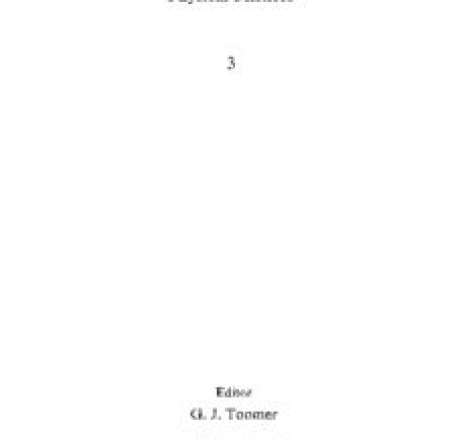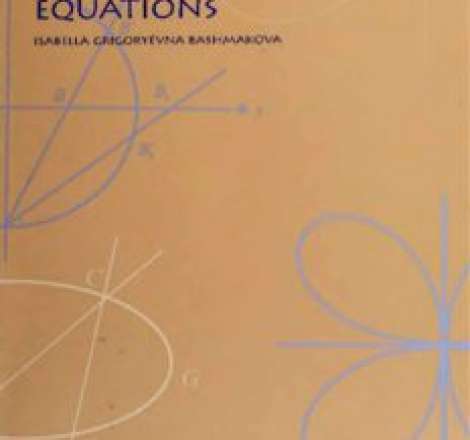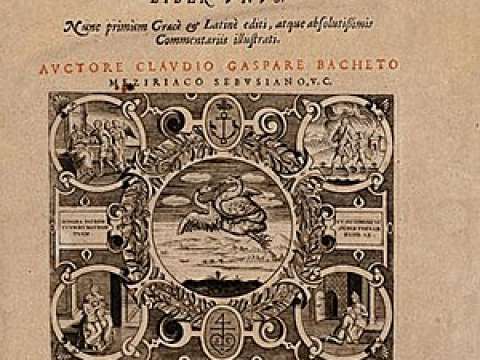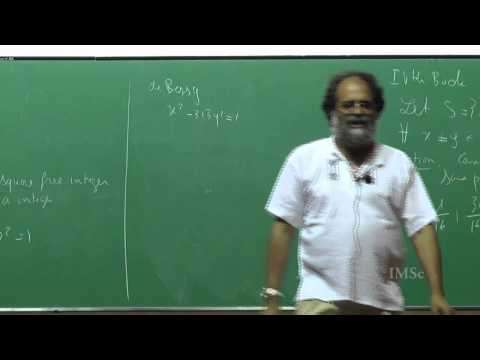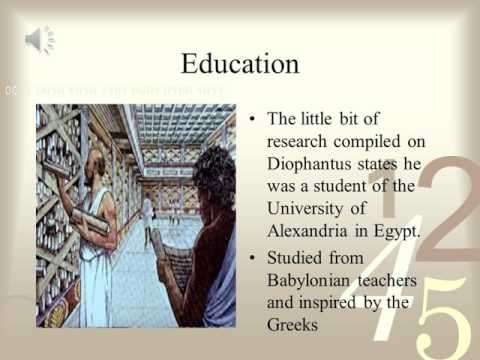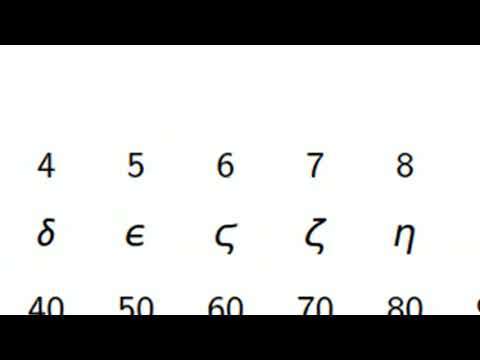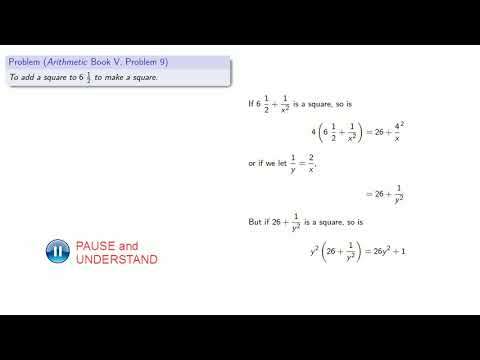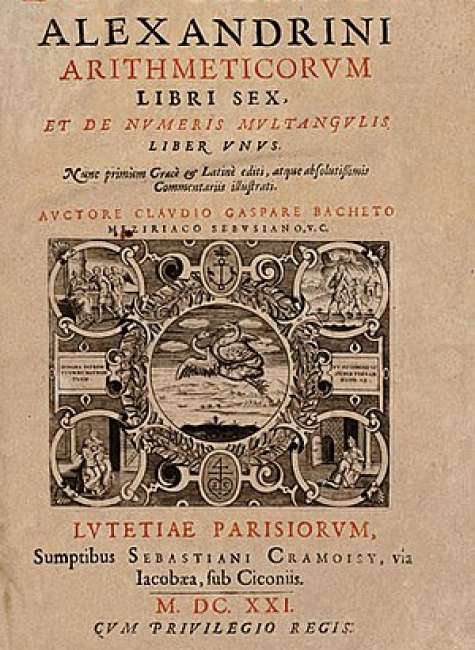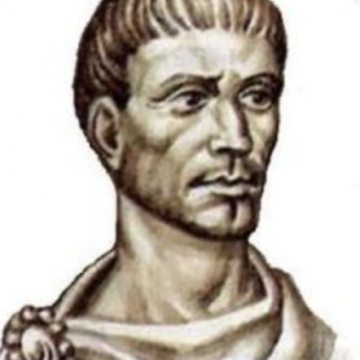

Diophantus (0214-0298)
If we arrive at an equation containing on each side the same term but with different coefficients, we must take equals from equals until we get one term equal to another term. But, if there are on one or on both sides negative terms, the deficiencies must be added on both bides until all the terms on both sides are positive. Then we must take equals from equals until one term is left on each side.
Diophantus of Alexandria was an Alexandrian mathematician, who was the author of a series of books called Arithmetica, many of which are now lost. His texts deal with solving algebraic equations. While reading Claude Gaspard Bachet de Méziriac's edition of Diophantus' Arithmetica, Pierre de Fermat concluded that a certain equation considered by Diophantus had no solutions, and noted in the margin without elaboration that he had found "a truly marvelous proof of this proposition," now referred to as Fermat's Last Theorem. This led to tremendous advances in number theory, and the study of Diophantine equations "Diophantine geometry" and of Diophantine approximations remain important areas of mathematical research. Diophantus coined the term παρισότης parisotes to refer to an approximate equality. This term was rendered as adaequalitas in Latin, and became the technique of adequality developed by Pierre de Fermat to find maxima for functions and tangent lines to curves. Diophantus was the first Greek mathematician who recognized fractions as numbers; thus he allowed positive rational numbers for the coefficients and solutions. In modern use, Diophantine equations are usually algebraic equations with integer coefficients, for which integer solutions are sought.
Biography
Little is known about the life of Diophantus. He lived in Alexandria, Egypt, during the Roman era, probably from between AD 200 and 214 to 284 or 298. Diophantus has variously been described by historians as either Greek, or possibly Hellenized Egyptian, or Hellenized Babylonian, Many of these identifications may stem from confusion with the 4th-century rhetorician Diophantus the Arab. Much of our knowledge of the life of Diophantus is derived from a 5th-century Greek anthology of number games and puzzles created by Metrodorus. One of the problems sometimes called his epitaph states:
'Here lies Diophantus,' the wonder behold.
Through art algebraic, the stone tells how old:
'God gave him his boyhood one-sixth of his life,
One twelfth more as youth while whiskers grew rife;
And then yet one-seventh ere marriage begun;
In five years there came a bouncing new son.
Alas, the dear child of master and sage
After attaining half the measure of his father's life chill fate took him. After consoling his fate by the science of numbers for four years, he ended his life.'
This puzzle implies that Diophantus' age x can be expressed as
x = x/6 + x/12 + x/7 + 5 + x/2 + 4
which gives x a value of 84 years. However, the accuracy of the information cannot be independently confirmed.
In popular culture, this puzzle was the Puzzle No.142 in Professor Layton and Pandora's Box as one of the hardest solving puzzles in the game, which needed to be unlocked by solving other puzzles first.
Arithmetica
Arithmetica is the major work of Diophantus and the most prominent work on algebra in Greek mathematics. It is a collection of problems giving numerical solutions of both determinate and indeterminate equations. Of the original thirteen books of which Arithmetica consisted only six have survived, though there are some who believe that four Arabic books discovered in 1968 are also by Diophantus. Some Diophantine problems from Arithmetica have been found in Arabic sources.

It should be mentioned here that Diophantus never used general methods in his solutions. Hermann Hankel, renowned German mathematician made the following remark regarding Diophantus.
“Our author Diophantos not the slightest trace of a general, comprehensive method is discernible; each problem calls for some special method which refuses to work even for the most closely related problems. For this reason it is difficult for the modern scholar to solve the 101st problem even after having studied 100 of Diophantos’s solutions”.
History
Like many other Greek mathematical treatises, Diophantus was forgotten in Western Europe during the so-called Dark Ages, since the study of ancient Greek, and literacy in general, had greatly declined. The portion of the Greek Arithmetica that survived, however, was, like all ancient Greek texts transmitted to the early modern world, copied by, and thus known to, medieval Byzantine scholars. Scholia on Diophantus by the Byzantine Greek scholar John Chortasmenos 1370–1437 are preserved together with a comprehensive commentary written by the earlier Greek scholar Maximos Planudes 1260 – 1305, who produced an edition of Diophantus within the library of the Chora Monastery in Byzantine Constantinople. In addition, some portion of the Arithmetica probably survived in the Arab tradition see above. In 1463 German mathematician Regiomontanus wrote:
No one has yet translated from the Greek into Latin the thirteen books of Diophantus, in which the very flower of the whole of arithmetic lies hidden . . . .
Arithmetica was first translated from Greek into Latin by Bombelli in 1570, but the translation was never published. However, Bombelli borrowed many of the problems for his own book Algebra. The editio princeps of Arithmetica was published in 1575 by Xylander. The best known Latin translation of Arithmetica was made by Bachet in 1621 and became the first Latin edition that was widely available. Pierre de Fermat owned a copy, studied it, and made notes in the margins.
Margin-writing by Fermat and Chortasmenos
The 1621 edition of Arithmetica by Bachet gained fame after Pierre de Fermat wrote his famous "Last Theorem" in the margins of his copy:
If an integer n is greater than 2, then an + bn = cn has no solutions in non-zero integers a, b, and c. I have a truly marvelous proof of this proposition which this margin is too narrow to contain.
Fermat's proof was never found, and the problem of finding a proof for the theorem went unsolved for centuries. A proof was finally found in 1994 by Andrew Wiles after working on it for seven years. It is believed that Fermat did not actually have the proof he claimed to have. Although the original copy in which Fermat wrote this is lost today, Fermat's son edited the next edition of Diophantus, published in 1670. Even though the text is otherwise inferior to the 1621 edition, Fermat's annotations—including the "Last Theorem"—were printed in this version.

Fermat was not the first mathematician so moved to write in his own marginal notes to Diophantus; the Byzantine scholar John Chortasmenos 1370–1437 had written "Thy soul, Diophantus, be with Satan because of the difficulty of your other theorems and particularly of the present theorem" next to the same problem.
Other works
Diophantus wrote several other books besides Arithmetica, but very few of them have survived.
The Porisms
Diophantus himself refers to a work which consists of a collection of lemmas called The Porisms or Porismata, but this book is entirely lost.
Although The Porisms is lost, we know three lemmas contained there, since Diophantus refers to them in the Arithmetica. One lemma states that the difference of the cubes of two rational numbers is equal to the sum of the cubes of two other rational numbers, i.e. given any a and b, with a > b, there exist c and d, all positive and rational, such that
a3 − b3 = c3 + d3.
Polygonal numbers and geometric elements
Diophantus is also known to have written on polygonal numbers, a topic of great interest to Pythagoras and Pythagoreans. Fragments of a book dealing with polygonal numbers are extant.
A book called Preliminaries to the Geometric Elements has been traditionally attributed to Hero of Alexandria. It has been studied recently by Wilbur Knorr, who suggested that the attribution to Hero is incorrect, and that the true author is Diophantus.
Influence
Diophantus' work has had a large influence in history. Editions of Arithmetica exerted a profound influence on the development of algebra in Europe in the late sixteenth and through the 17th and 18th centuries. Diophantus and his works also influenced Arab mathematics and were of great fame among Arab mathematicians. Diophantus' work created a foundation for work on algebra and in fact much of advanced mathematics is based on algebra. How much he affected India is a matter of debate.
Diophantus is often called “the father of algebra" because he contributed greatly to number theory, mathematical notation, and because Arithmetica contains the earliest known use of syncopated notation.
Diophantine analysis
Today, Diophantine analysis is the area of study where integer whole-number solutions are sought for equations, and Diophantine equations are polynomial equations with integer coefficients to which only integer solutions are sought. It is usually rather difficult to tell whether a given Diophantine equation is solvable. Most of the problems in Arithmetica lead to quadratic equations. Diophantus looked at 3 different types of quadratic equations: ax2 + bx = c, ax2 = bx + c, and ax2 + c = bx. The reason why there were three cases to Diophantus, while today we have only one case, is that he did not have any notion for zero and he avoided negative coefficients by considering the given numbers a, b, c to all be positive in each of the three cases above. Diophantus was always satisfied with a rational solution and did not require a whole number which means he accepted fractions as solutions to his problems. Diophantus considered negative or irrational square root solutions "useless", "meaningless", and even "absurd". To give one specific example, he calls the equation 4 = 4x + 20 'absurd' because it would lead to a negative value for x. One solution was all he looked for in a quadratic equation. There is no evidence that suggests Diophantus even realized that there could be two solutions to a quadratic equation. He also considered simultaneous quadratic equations.
Mathematical notation
Diophantus made important advances in mathematical notation, becoming the first person known to use algebraic notation and symbolism. Before him everyone wrote out equations completely. Diophantus introduced an algebraic symbolism that used an abridged notation for frequently occurring operations, and an abbreviation for the unknown and for the powers of the unknown. Mathematical historian Kurt Vogel states:
The symbolism that Diophantus introduced for the first time, and undoubtedly devised himself, provided a short and readily comprehensible means of expressing an equation... Since an abbreviation is also employed for the word ‘equals’, Diophantus took a fundamental step from verbal algebra towards symbolic algebra.
Although Diophantus made important advances in symbolism, he still lacked the necessary notation to express more general methods. This caused his work to be more concerned with particular problems rather than general situations. Some of the limitations of Diophantus' notation are that he only had notation for one unknown and, when problems involved more than a single unknown, Diophantus was reduced to expressing "first unknown", "second unknown", etc. in words. He also lacked a symbol for a general number n. Where we would write 12 + 6n/n2 − 3, Diophantus has to resort to constructions like: "... a sixfold number increased by twelve, which is divided by the difference by which the square of the number exceeds three".
Algebra still had a long way to go before very general problems could be written down and solved succinctly.
















